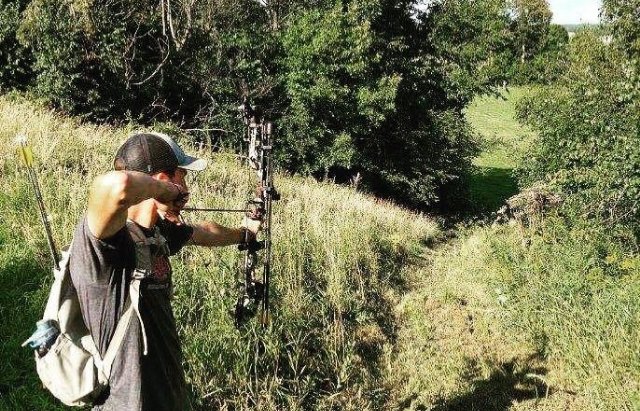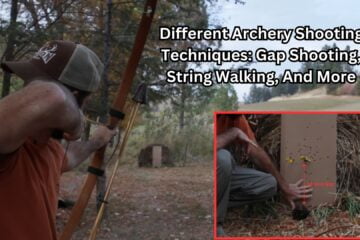To shoot arrows on different terrain, archers must adjust their stance, aim, and release accordingly. In this article, we’ll discuss various archery techniques that can help you master shooting on different types of terrain.
Whether it’s a downhill slope, uneven ground, or shooting from elevated positions, we’ll provide you with tips for improving your accuracy and form. Shooting on different terrain presents unique challenges, but with proper training and techniques, you can become a versatile archer capable of hitting any target in any environment.
So, let’s dive in and explore the world of archery on different terrains.

Credit: archerycountry.com
Equipment For Different Terrains
Discuss The Importance Of Selecting The Appropriate Equipment For Different Types Of Terrain.
When it comes to archery, using the right equipment is crucial to your success. Different types of terrain require different equipment, and it’s essential to choose the appropriate gear. Here’s why selecting the correct equipment for different terrains is crucial:
- Without the proper equipment, you risk injury, inaccuracy, and other negative consequences that could impact your ability to shoot accurately.
- Using the right equipment for the specific terrain you’re shooting on improves the likelihood of hitting your target.
- Certain types of equipment may be more comfortable for you to use on specific terrain, and using equipment that you’re comfortable with can improve your overall shooting technique.
Elaborate On The Types Of Bows And Arrows That Are Best Suited For Different Terrains.
Choosing the right bow and arrow is critical when shooting on different types of terrain. Here are the types of bows and arrows best suited for different terrains:
- Flat terrain: When shooting on flat terrain, a longbow or recurve bow may work well. These types of bows offer excellent accuracy and are user-friendly.
- Hilly terrain: For hilly terrain, a compound bow would be the best choice. With the ability to adjust the draw weight and length, you’ll be able to shoot accurately even when dealing with uneven terrain.
- Woodland terrain: A crossbow is the best option for woodland terrain. It allows you to shoot accurately with minimal noise, preventing spooking the wildlife around you.
In addition to the kind of bow, choosing the right arrow is just as important:
- Carbon arrows are ideal for hilly terrain because they are lightweight and can travel further distances.
- For flat terrain, you can opt for a heavier arrow because you don’t have to worry about it being too difficult to launch.
- In woodland terrain, you can use a shorter, lighter, and quieter arrow that won’t spook any nearby wildlife.
Mention The Types Of Accessories Required For Different Terrains.
Using additional accessories can significantly enhance your shooting technique and overall experience. Here are the types of accessories required for different terrains:
- Flat terrain: A bow stabilizer will help in shooting accurately on flat terrain. It reduces the recoil and vibration of the bow, providing stability to the bow arm and improving the accuracy of the shot.
- Hilly terrain: Arrow rests are crucial when shooting on uneven terrain. They help keep the arrow in place, leaving you free to deal with the inclines and declines of the area.
- Woodland terrain: A quiver can be incredibly useful in this terrain. It allows you to carry your arrows in a way that’s easily accessible, providing a quick reload in any situation.
By knowing the right equipment and accessories to use in different types of terrain, you’ll not only be able to shoot accurately but also improve your overall experience as an archer.
Techniques For Shooting On Hilly Terrain
Archery techniques for shooting on different terrain: techniques for shooting on hilly terrain
Shooting on hilly terrain is one of the most challenging aspects of archery. It requires a solid understanding of your gear, proper positioning, and an ability to quickly adapt to the constantly-changing angles. In this guide, we’ll take a closer look at the key points to keep in mind when shooting in hilly terrain and essential techniques for improving your shot.
Discuss The Challenges Faced When Shooting In Hilly Terrain And How To Overcome Them
Shooting on hilly terrain poses multiple challenges, ranging from uneven ground and rough footing to the obstacles that can obstruct your shot. However, overcoming these challenges is not impossible. Here are some tips to help you overcome the challenges of shooting on hilly terrain:
- Take a few moments to assess the terrain before shooting.
- Position yourself for maximum stability and control.
- Consider the placement of your shot before releasing.
Explain The Importance Of Maintaining Proper Balance And Positioning While Shooting
Maintaining proper balance and positioning while shooting is crucial to hitting your target. When shooting uphill or downhill, it’s essential to keep your weight evenly distributed to ensure optimal stability and control. Here are some key points to keep in mind when maintaining balance and positioning on hilly terrain:
- Keep your feet shoulder-width apart and point them perpendicular to the desired target.
- Position your bow arm towards the target.
- Bend your knees slightly to help maintain stability.
Mention The Different Techniques For Shooting Uphill And Downhill, Including Shot Placement And Bow Angle
When shooting uphill or downhill, it’s essential to adapt your technique to the terrain. This adaptation includes considering the angle of the shot, shot placement, and bow angle. Here are some tips for shooting uphill and downhill:
Shooting uphill:
- Aim higher than the target.
- Use a shorter draw length.
- Keep your feet firmly planted on the ground.
- Position your bow arm slightly higher than the target.
Shooting downhill:
- Aim lower than the target.
- Use a longer draw length.
- Keep your feet firmly planted on the ground.
- Position your bow arm lower than the target.
Shooting on hilly terrain can be challenging, but when you understand the obstacles, maintain proper positioning, and adapt your techniques, you can improve your accuracy and become a more proficient archer. These techniques can help you better understand what to look for when shooting on hilly terrain, so you can build your skills and face any challenge with confidence.
Techniques For Shooting On Rocky Terrain
Archery techniques for shooting on different terrain: techniques for shooting on rocky terrain
Shooting on rocky terrain can be quite challenging for novice and experienced archers alike. It requires a special set of skills to overcome the obstacles that come with rocky terrain. In this section, we will discuss some of the common challenges that archers face when shooting on rocky terrain and how to overcome them.
We will also share some tips on how to avoid damaging arrows and equipment, and the importance of shooting from a stable position and foot placement.
Discuss The Challenges Faced When Shooting On Rocky Terrain And How To Overcome Them.
- Rocky terrain can affect an archer’s stability and accuracy, leading to missed targets or damage to arrows and equipment.
- Archers need to be mindful of their footing as rocky terrain can be slippery and uneven, posing a potential risk for injury or accidents.
- To overcome these challenges, archers need to learn how to shoot from a stable position and foot placement, which we will discuss in the next section.
Elaborate On The Importance Of Shooting From A Stable Position And Foot Placement.
- Shooting from a stable position is crucial when shooting on rocky terrain, as it allows archers to maintain their balance and improve their accuracy.
- Foot placement is equally important, as it provides archers with a solid foundation and helps distribute their weight evenly.
- Archers should keep their feet flat on the ground, with their weight evenly distributed on both feet, and their stance shoulder-width apart.
- Lean slightly forward and keep your spine straight to improve your posture, which will help you shoot with greater precision.
Mention Tips On How To Avoid Damaging Arrows And Equipment While Shooting On Rocky Terrain.
- When shooting on rocky terrain, use arrows with field tips instead of broadheads, as broadheads can get stuck in rocks, damaging the arrow and causing it to become unusable.
- Be mindful of your surroundings, and avoid shooting towards rock formations or areas with loose rocks that could damage arrows or equipment.
- Carry spare parts and equipment, such as extra arrows and nocks, in case of damage or loss.
- When not in use, keep your equipment in a secure and damage-free location to avoid unnecessary wear and tear.
Shooting on rocky terrain requires a unique set of skills that archers need to master. Shooting from a stable position and foot placement, being mindful of surroundings, and carrying spare parts and equipment are essential practices that help overcome the challenges of shooting on rocky terrain.
By following these tips, archers can better protect their equipment and improve their accuracy, even on the most challenging terrain.
Techniques For Shooting On Forest Terrain
Archery Techniques For Shooting On Different Terrain
When it comes to archery, shooting in various types of terrains can prove challenging for both beginners and experienced archers. Each terrain has its unique challenges, and as such, archers need to develop and master distinct techniques to overcome them.
Shooting in the forest is one of the most challenging terrains that require archers to be keenly aware of their surroundings. In this section, we explore the techniques for shooting on forest terrain and how to overcome the challenges posed by this landscape.
Discuss The Challenges Faced When Shooting In Forest Terrain And How To Overcome Them.
Shooting in a forest presents a variety of unique challenges, which require archers to be extremely cautious and agile. Some of the challenges include:
- Limited visibility due to trees and vegetation.
- Varying light conditions, which can affect shot placement and accuracy.
- Uneven terrain, which can cause archers to lose balance and stability.
- Trees and branches, which can interfere with shot placement and make it challenging to find a clear shot.
- Wildlife, which can cause distractions and disrupt concentration.
To overcome these challenges, archers are advised to do the following:
- Scout the area beforehand to familiarize yourself with the terrain and any potential obstacles.
- Maintain situational awareness by constantly surveying your surroundings and being wary of any potential disturbances.
- Practice shot placement techniques that are specifically tailored to forest terrain.
- Position yourself strategically to ensure that you have a clear line of sight and can shoot safely.
- Adjust your technique to accommodate for any variation in light conditions.
Explain The Importance Of Maintaining Situational Awareness And Handling Obstacles.
Maintaining situational awareness is vital when shooting on forest terrain as it helps archers avoid potential obstacles and stay safe. Archers need to be aware of their surroundings at all times, taking care to avoid trees, branches, and other obstacles that might interfere with their shot.
Additionally, archers need to be alert to any potential distractions, such as wildlife, that might cause them to lose concentration and focus.
To overcome obstacles when shooting in the forest, archers can do the following:
- Stay alert at all times to any potential obstacles and hazards.
- Take time to navigate the terrain and identify any obstacles before taking the shot.
- Adjust your technique to accommodate for the terrain and any obstacles.
- If necessary, move to a different position to ensure that the shot is safe and clear.
Mention The Different Techniques, Including Shot Placement, Positioning, And How To Handle Varying Light Conditions.
In forest terrain, shot placement plays a crucial role in determining the level of success an archer will achieve. One of the best techniques for enhancing shot placement on forest terrain is the use of broadhead arrows. These types of arrows are designed to pass through dense undergrowth and foliage, ensuring that archers can achieve clean, accurate shots.
Positioning is another critical technique that archers need to master when shooting in forest terrain. Archers need to position themselves strategically to ensure that they have a clear line of sight and can shoot safely. One such position is the tree stand, which provides a bird’s eye view of the forest, ensuring that archers can spot their target and take accurate shots.
Lastly, archers need to handle varying light conditions when shooting in forest terrain. The key to addressing this issue is to adjust your shooting technique to accommodate the conditions. Many archers prefer to use a peep sight, which allows them to see through varying light conditions accurately.
Additionally, archers can use illuminated pins to ensure that they can aim accurately, even when the light conditions are less than optimal.
Mastering archery techniques for shooting on different terrains is critical to becoming an experienced and successful archer. When shooting in forest terrain, archers should keep in mind the unique challenges posed by this landscape and adjust their techniques accordingly. By following the techniques and advice outlined above, archers can master the art of shooting in forest terrain and achieve their desired level of success.
Techniques For Shooting On Wet Terrain
Archery Techniques For Shooting On Different Terrain
Archery is a fascinating sport that requires a combination of physical strength, mental focus, and technical skill. Understanding how to shoot arrows on different types of terrain can help archers shoot more consistently and effectively. Shooting on wet terrain poses unique challenges that require specific techniques to overcome.
Discuss The Challenges Faced When Shooting On Wet Terrain And How To Overcome Them.
Shooting on wet terrain can be challenging due to the slipperiness of the ground, which can cause archers to lose their balance and make inaccurate shots. Additionally, moisture can affect equipment and arrows, altering their weight and trajectory. To overcome these challenges, archers can use the following techniques:
- Proper footing: To maintain balance and stability on wet terrain, archers should take small steps and distribute their weight evenly. Plastic or rubber-soled shoes can provide better grip than standard shoes.
- Shot placement: Arrows are more likely to deflect when shooting on wet terrain. Therefore, archers should aim for the center of the target to reduce the probability of arrow deflection.
- Bow angle: As moisture can affect the bowstring’s grip, archers should adjust their bow angle to compensate for the changes in arrow trajectory.
Explain How Moisture Can Impact The Equipment And Arrows.
Moisture can affect the weight and balance of equipment and arrows. For example, wet bows can become heavier, while damp arrow fletchings can increase air resistance, causing them to stray from their intended path. Furthermore, damp bowstrings can stretch, affecting their grip on the bow limbs.
To mitigate the impact of moisture, archers can cover their equipment and arrows with waterproof material and dry them regularly.
By applying appropriate techniques for shooting on wet terrain, archers can maintain their accuracy and performance in any weather condition. Practice is key, and archers should incorporate wet terrain shooting into their training routine to improve their overall skills.
Frequently Asked Questions Of Archery Techniques For Shooting On Different Terrain
What Are The Best Archery Techniques For Shooting On Uneven Terrain?
To master shooting on uneven terrain, it’s important to have a strong stance with your feet shoulder-width apart. Always aim uphill, and be consistent with the arrow placement on the bowstring. Practice uphill, downhill, and side slope shots to build skill.
How Do I Prepare For Archery On Rugged Terrain?
Start by researching the area where you plan to hunt or shoot. Attend a shooting course that covers terrain-specific training. Test your gear, and always pack plenty of water and food. Hike the terrain beforehand to become familiar with the area and identify potential obstacles.
What Is The Best Way To Shoot Uphill Or Downhill?
When shooting uphill, aim higher than the target and adjust your stance with one foot higher than the other. For downhill, aim lower than the target, with your stance adjusted similarly. Keep in mind that distances may seem deceivingly shorter or further than they appear, so always estimate the yardage accurately.
Conclusion of Archery Techniques for Shooting
It’s evident that archery on different terrains requires specific techniques, skills and equipment. Depending on whether you’re shooting uphill or downhill, on a windy or flat terrain, you must adjust your stance, draw, aim and release to ensure maximum accuracy and consistency.
Finding the right balance between power and precision is crucial, and it’s only achieved through practice, patience and dedication. Remember to maintain your focus, stay relaxed and confident, and don’t get discouraged by initial failures. Keep in mind that each target and terrain presents a unique challenge, and it’s up to you to find the best approach to overcome it.
With the above tips, you’re well on your way to mastering the art of archery, and shooting with confidence and success, regardless of the terrain.







